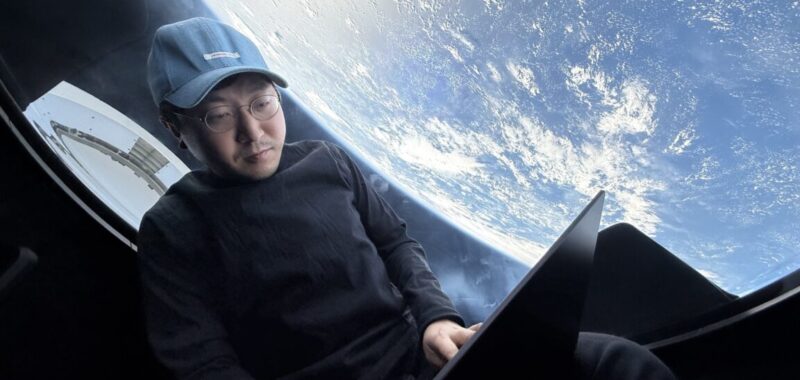“It was not 100 percent available, but when it was, it was really fast,” Chun wrote of the Internet connection in an email to Ars. He told us he used an iPhone 16 Pro Max for his 4K videos. From some 200 miles (300 kilometers) up, the phone’s 48-megapixel camera, with a simulated optical zoom, brought out the finer textures of ice sheets, clouds, water, and land formations.
While the flight was fully automated, SpaceX trained the Fram2 crew how to live and work inside the Dragon spacecraft and take over manual control if necessary. None of Fram2 crew members had a background in spaceflight or in any part of the space industry before they started preparing for their mission. Notably, it was the first human spaceflight mission to low-Earth orbit without a trained airplane pilot onboard.

Chun Wang, far right, extends his arm to take an iPhone selfie moments after splashdown in the Pacific Ocean.
Credit:
SpaceX
Their nearly four days in orbit was largely a sightseeing expedition. Alongside Chun, Mikkelsen put her filmmaking expertise to use by shooting video from Dragon’s cupola. Before the flight, Mikkelsen said she wanted to create an immersive 3D account of her time in space. In some of Wang’s videos, Mikkelsen is seen working with a V-RAPTOR 8K VV camera from Red Digital Cinema, a device that sells for approximately $25,000, according to the manufacturer’s website.
The crew spent some of their time performing experiments, including the first X-ray of a human in space. Scientists gathered some useful data on the effects of radiation on humans in space because Fram2 flew in a polar orbit, where the astronauts were exposed to higher doses of ionizing radiation than a person might see on the International Space Station.
After they splashed down in the Pacific Ocean at the end of the mission, the Fram2 astronauts disembarked from the Dragon capsule without the assistance of SpaceX ground teams, which typically offer a helping hand for balance as crews readjust to gravity. This demonstrated how people might exit their spaceships on the Moon or Mars, where no one will be there to greet them.
Going into the flight, Chun wanted to see Antarctica and Svalbard, the Norwegian archipelago where he lives north of the Arctic Circle. In more than 400 human spaceflight missions from 1961 until this year, nobody ever flew in an orbit directly over the poles. Sophisticated satellites routinely fly over the polar regions to take high-resolution imagery and measure things like sea ice.
The Fram2 astronauts’ observations of the Arctic and Antarctic may not match what satellites can see, but their experience has some lasting catchet, standing alone among all who have flown to space before.
“People often refer to Earth as a blue marble planet, but from our point of view, it’s more of a frozen planet,” Chun told Ars.

